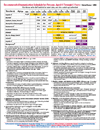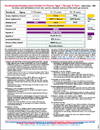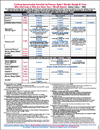Recommendations and Guidelines:
2009 Child & Adolescent Immunization Schedules
for persons aged 0-6 years, 7-18 years, and "catch-up schedule"
The Schedules lists the ages (birth through 6 years old and 7 through 18 years old) for when each vaccine or series of shots is to be given. If your child or adolescent has missed any shots, consult the catch-up schedule AND check with your doctor about getting back on track.
![]() Get Email Updates
Get Email Updates

On This Page:
2009 Schedules

PERSONS AGED 0-6 years
- Color for office printing
 new Jan 2, 2009
new Jan 2, 2009 - Color for commercial press printer
 new Jan 2, 2009
new Jan 2, 2009

PERSONS AGED 7-18 years
- Color for office printing
 new Jan 2, 2009
new Jan 2, 2009 - Color for commercial press printer
 new Jan 2, 2009
new Jan 2, 2009

CATCH-UP schedule (4 months to 18 years)
- Color for office printing
 new Jan 2, 2009
new Jan 2, 2009 - Color for commercial press printer
 new Jan 2, 2009
new Jan 2, 2009 - Interactive Catchup Scheduler
This tool once downloaded can be used to determine the vaccines your child needs and is especially useful for quickly seeing missed or skipped vaccines according to the Immunization scheduler.
MMWR of Recommended Schedules (published January 02, 2009)
The recommended immunization schedules for persons aged 0 through 18 years and the catch-up immunization schedule for 2009 have been approved by the Advisory Committee on Immunization Practices (ACIP), the American Academy of Pediatrics (AAP), and the American Academy of Family Physicians (AAFP).
This version also serves as a text-only for screen-reader devices.
Print-friendly version ![]() (see pages 37-40 of this 40 page document)
(see pages 37-40 of this 40 page document)
Changes in the Schedule since last release
Changes listed here are outlined in MMWR with figures, etc.
- Recommendations for rotavirus vaccines include changes for the maximum age for the first dose (14 weeks 6 days) and the maximum age for the final dose (8 months 0 days). The rotavirus footnote also indicates that if RV1 (Rotarix®) is administered at ages 2 and 4 months, a dose at 6 months is not indicated .
- Routine annual influenza vaccination is recommended for all children aged 6 months through 18 years. Children aged younger than 9 years who are receiving influenza vaccine for the first time or who were vaccinated for the first time during the previous season but only received 1 dose should receive 2 doses of influenza vaccine at least 4 weeks apart. Healthy nonpregnant persons aged 2 through 49 years may receive either live attenuated influenza vaccine or inactivated influenza vaccine.
- The minimum interval between tetanus and diphtheria toxoids (Td) and tetanus and diphtheria toxoids and acellular pertussis vaccine (Tdap) for persons aged 10 through 18 years is addressed. An interval less than 5 years may be used if pertussis immunity is needed .
- Information about the use of Haemophilus influenzae type b (Hib) conjugate vaccine among persons aged 5 years and older at increased risk for invasive Hib disease has been added. Use of Hib vaccine for these persons is not contraindicated.
- Catch-up vaccination with human papillomavirus (HPV) vaccine is clarified. Routine dosing intervals should be used for series catch-up (i.e., the second and third doses should be administered 2 and 6 months after the first dose). The third dose should be given at least 24 weeks after the first dose.
- Abbreviations for rotavirus, pneumococcal polysaccharide and meningococcal polysaccharide vaccines have been changed.
Presentation Graphics
These images are only the chart portions of the immunization schedule and are provided for use in PowerPoint Presentations:
- jpg image 1
 (.jpg - 494 KB) (chart only-birth to 6 years) new Jan 2, 2009
(.jpg - 494 KB) (chart only-birth to 6 years) new Jan 2, 2009 - jpg image 2
 (.jpg - 561 KB) (chart only-7 to 18 years) new Jan 2, 2009
(.jpg - 561 KB) (chart only-7 to 18 years) new Jan 2, 2009 - jpg image 3
 (.jpg - 405 KB) (catch-up chart-4 mos. to 18 yrs.) new Jan 2, 2009
(.jpg - 405 KB) (catch-up chart-4 mos. to 18 yrs.) new Jan 2, 2009
Reproduction Instructions
The color versions are the preferred files for office printer and commercial/professional printer use. Black-and-white versions are intended only for those who must print in black and white.
Tip: If you wish to save printer toner, use a color copier to make additional copies.
Related Topics
- Interactive child's immunization scheduler (birth-6 years old)
- Child immunization and "scheduler" brochures
- ACIP Recommendations
- Summary of Recommendations for Childhood & Adolescent Immunization
 (exit)
(exit) - Blank vaccine record forms
- Vaccines in delay or shortage
- Article: "Economic Evaluation of the 7-Vaccine Routine Childhood Immunization Schedule in the U.S., 2001" (exit) from Dec. 2005 - Archives of Pediatrics and Adolescent Medicine
- Vaccines for teens and college students
- Vaccines for adults (adult immunization schedule)
- Additional info about adolescent and adult vaccines
- History of the Vaccine Schedule (exit)
- Childhood Schedules from Past Years
*MMWR--Morbidity and Mortality Weekly Report
Note: Please contact NIPINFO@cdc.gov via e-mail for assistance with accessing copies not provided above.
Non-CDC Link Disclaimer: Links to non-Federal organizations found at this site are provided solely as a service to our users. These links do not constitute an endorsement of these organizations or their programs by CDC or the Federal Government, and none should be inferred. The CDC is not responsible for the content of the individual organization web pages found at these links.
.pdf files: To view and print the .pdf files on this site, you will need Adobe Acrobat Reader. Use this link to obtain a free copy of Adobe Acrobat Reader (exit). We highly recommend that you upgrade to the latest version if haven't already.
This page last modified on January 7, 2009
Content last reviewed on January 2, 2009
Content Source: National Center for Immunization and Respiratory Diseases